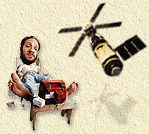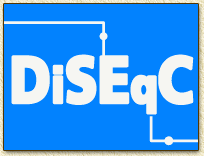
| Print this page - use Landscape |
Search the WeetHet Pages |
|||||
| WeetHet is being updated! - Current articles will slowly move to www.tweaking4all.com For excellent webhosting that is reliable and affordable, we highly recommend: LiquidWeb |
||||||
|
Op deze pagina ...
Why DiSEqC? Older satellite recievers started to create their own little standard and solution for several switching purposes. This started to confuse customers (which works with what?) so it was time for a decent standard. Some satelliet recievers use a 14/18 Volts currency
to switch between the Horizontal and Vertical polarisation. Now-a-days the upper frequency range (11,7 to 12,75 GHz) becomes more and more of interest for use in digital programs. The LNB's used for this purpose are universal LNB's (10,7-11,7 and 11,7-12,75 GHz) which use the 22kHz-Signal to switch between these two frequency ranges. This however is in conflict with the original use of the 22Khz Tone-Burst: siwtching between two satellites. Using DiSEqC changes this for the better. In our digital world, we can send digital commands to the add-on equipment. DiSEqC is downwards compatible, so older equipment should work just fine with newer DiSEqC equipment. It's true that a DiSEqC 2.0 compatible receiver kan work just fine with a DiSEqC 1.0 LNB-switch. The otherway around might or might not work, it all depends on the switch. Most of them do listen to DiSEqC 1.0 commands, some don't. TIP: Make sure that you can return the switch if it's not working properly. The concept of DiSEqC continues to use 14/18 Volts and 22Khz tone-burst concept. DiSEqC additionally uses digital commands to control equipment (naturally, both receiver and switch must be DiSEqC compatible). DiSEqC is of use for both analog, digital and analog/digital systems. DiSEqC variants
DiSEqC 1.0 DiSEqC Version 1.0 allows you to connect up to 4 receivers to your receiver, where the receiver (master) controls the switch (slave) by sending digital commands for selecting the desired LNB. These signals are used: DiSEqC 1.0 uses: Special LNB's allow you to use the Loop-Through signal, where the 2nd LNB's signal is being routed through the 1st LNB. This works with DiSEqc 1.0. DiSEqc 1.2 Can additionally be used for automatically control of rotor-based dishes. DiSEqC 2.0 DiSEqC 2.0 adds a return channel, used for getting information on the connected add-ons. It will inform the reciever, after sending a particular signal, about the amound and type of LNB's available and how they are interconnected. Particular 2.0 applications (Next to the 1.0 applications): DiSEqC 2.1 Adds the ability to control up to 64 LNB's, I can't imagine what my house would look like with that many dishes, but hey,... you can if you want to (sent me a picture!). Which DiSEqC version do I need? When using only one dish, with 1 LNB for only one satellite: basically any equipment will do just fine. If you want to receive 2 satellites, for example the Astra and the Hotbird (EutelSat), your reciever should at least be able to control one switch, using any DiSEqC version. Actually a Tone-Burst ability should be sufficient. When using 3 or more dishes, you will definitly need at least DiSEqC 1.0 or higher (depending on what your setup looks like). When using a rotor for your dish to change position, you should go for DiSQeC 1.2 or higher. Note that almost ALL LNB switches support DiSEqC 2.0, but often they are able to work with lower versions aswell. At least that is what is said... only experimentation will show if it works, so make sure you can return the switch if it doesn't work. Most LNB switches sold in Europe are inteded to work with the Astra and the Hotbird (Eutelsat). This implies they should work with the receivers for these satellites aswell. Most modern receivers support at least DiSEqC 1.0 anyway. |
||||||


